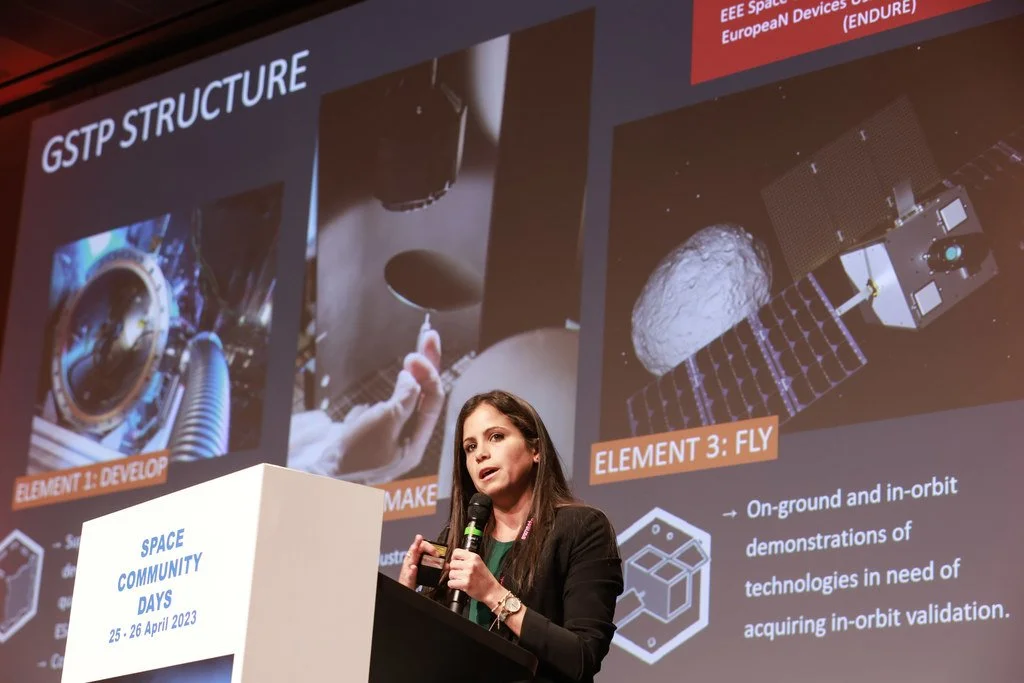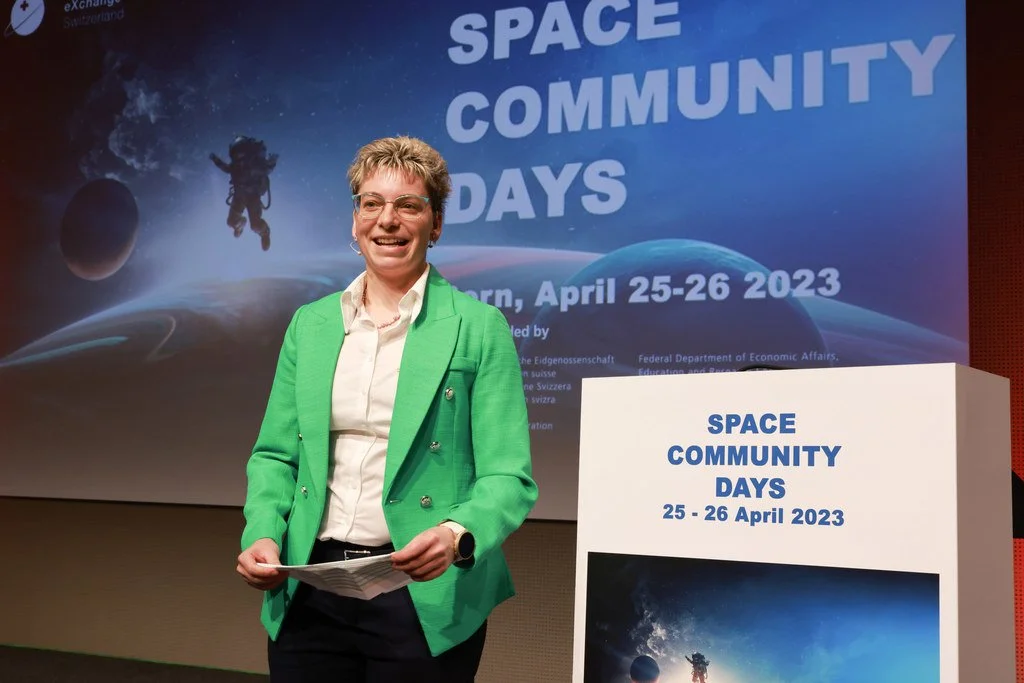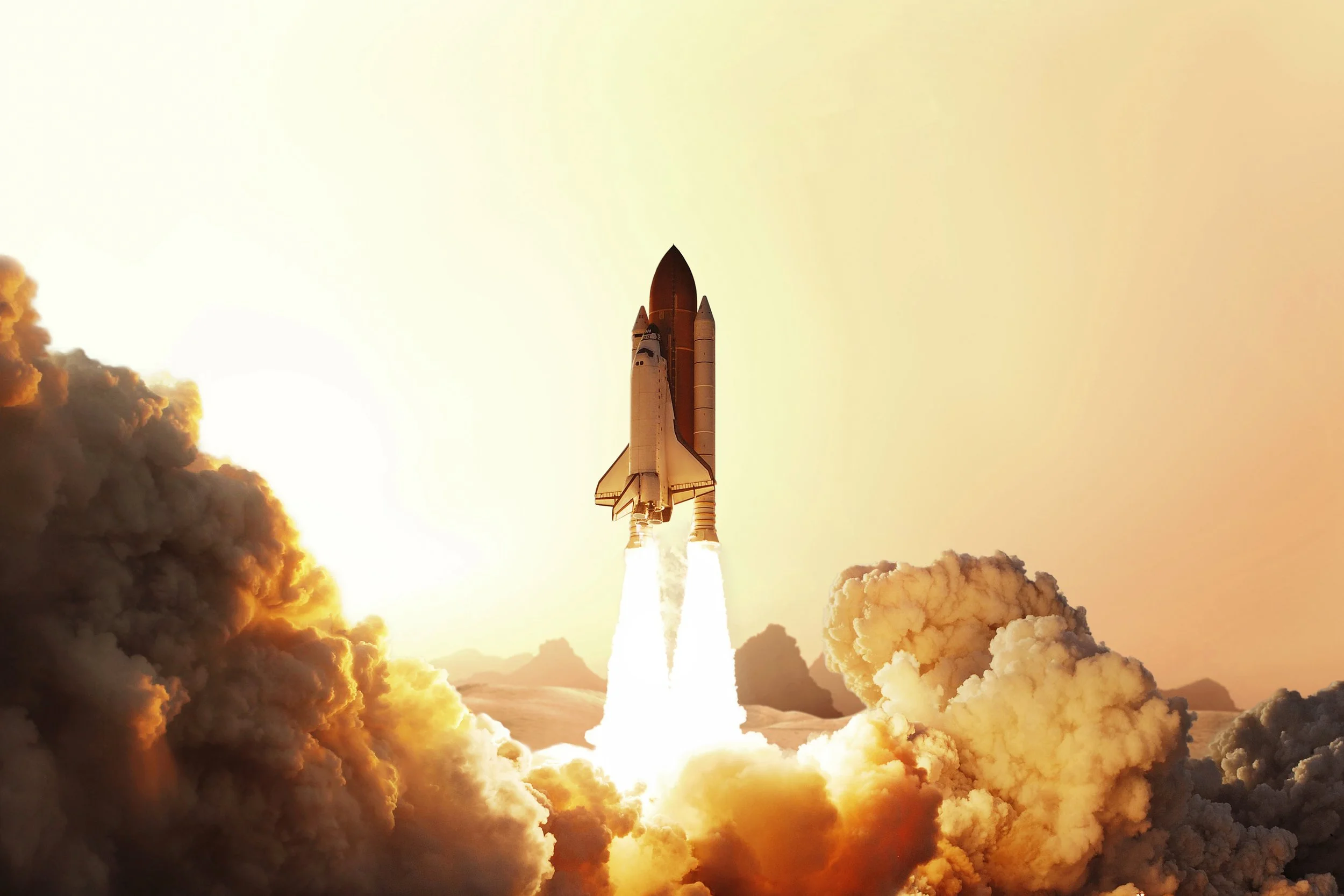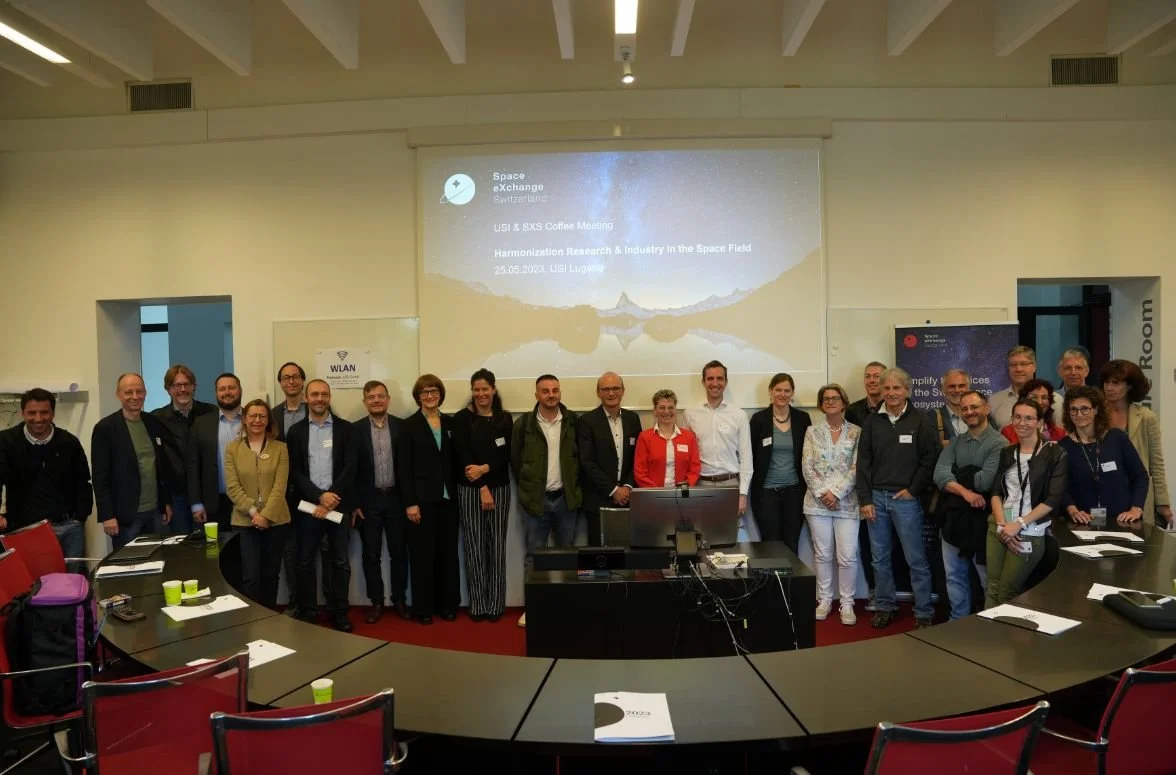
News and Press
SXS NEWS
“FOCUS SPACE” Serie - produced by Space Exchange Switzerland
Through a new series, called “Focus Space”, shared on our social networks since March 2025, we are highlighting new projects or stories from the space sector.
These short, engaging, and professionally produced videos aim to share inspiring company journeys with a broad audience of space enthusiasts. The first episode, now available on our platforms, features the successful launch of the Clustergate-1 platform, designed by the Swiss-startup DPhi Space.
FOCUS SPACE EP.1 I Meet Aziz Belkhiria, co-founder and CEO of DPhi Space
👏 DPhi Space celebrates a major milestone with the successful launch of its Clustergate platform on Saturday, March 15!
🚀 Aziz shares with us the journey of the Clustergate-1, a Swiss-made shared platform designed for hosted payloads.
🛰️ How does Clustergate operate? What were the biggest challenges leading up to its launch? And what advice does Aziz have for aspiring space entrepreneurs?
He shares his journey and insights with us!
Commercial Space Days 2023
Space Exchange Switzerland had the privilege of co-organizing the Space Commercial Days 2023 in KKL Luzern.
This great conference delved into a wide range of topics, including opportunities, commercialization, careers, and more within the space industry. It provided an invaluable platform for space professionals to connect, exchange experiences, and foster collaboration within the sector. We are grateful for the opportunity to have been a part of this event and look forward to further contributing to the advancement of the space industry.
A big thank you to the organizing team for a very successful event!





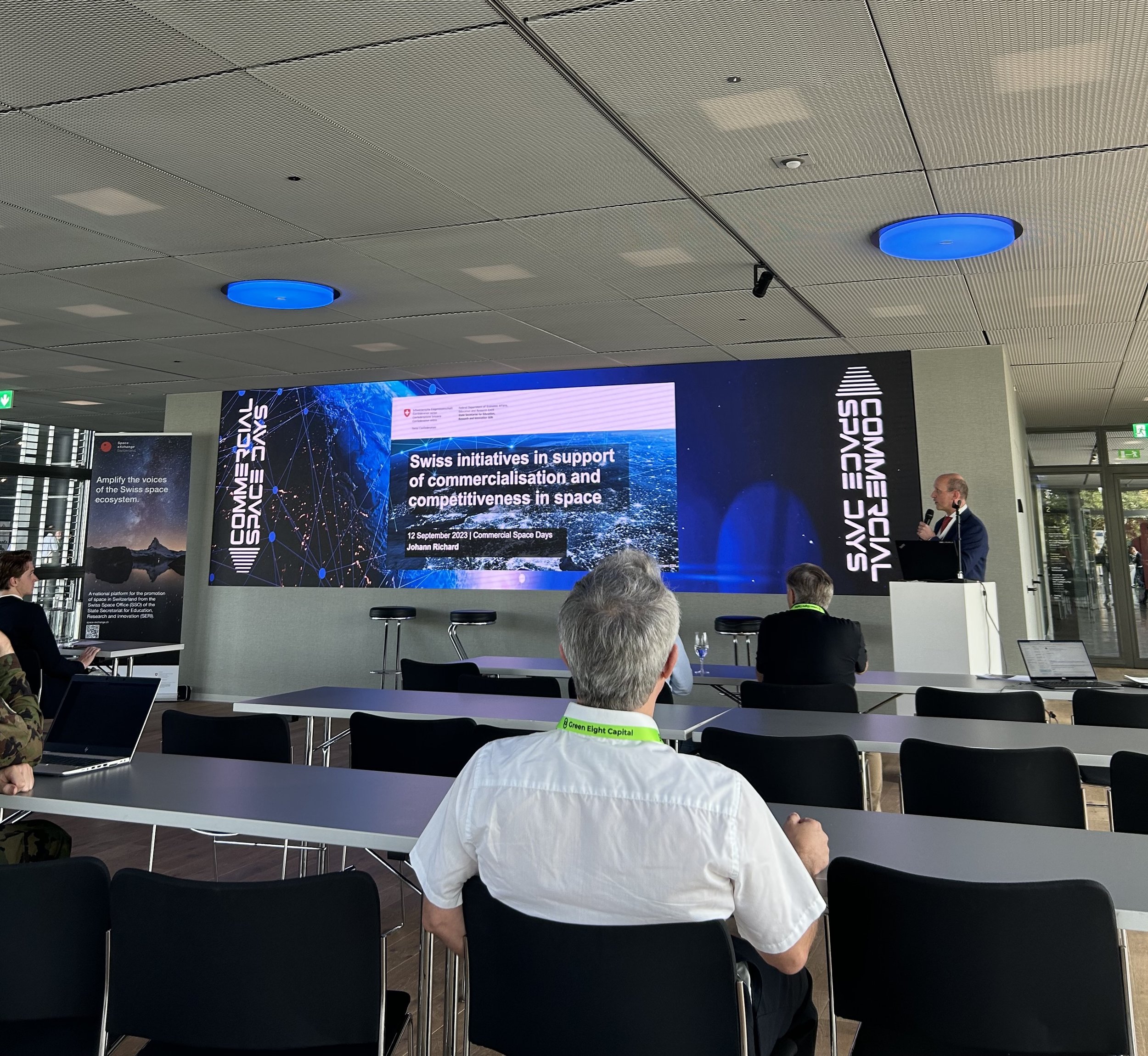
Swiss Community Days 25 & 26 April
More than 200 participants were present at our space community days in Bern on the 25th and 26th April. High quality presentations with concrete opportunities for swiss stakeholders, fruitful B2B meetings and a lot of good feedback! See all the pictures here!
NEWS
Call for interest: Swiss ESA astronaut MarcocSieber ’s First Mission to Space.
In April 2024 Marco Sieber qualified as an astronaut of the European Space Agency ESA, thus becoming Switzerland’s second astronaut. He will also be the first Swiss national to fly a six-month mission to the International Space Station ISS. This mission is expected to take place between 2027 and 2029. In its capacity as the Swiss Delegation to ESA, the Swiss Space Office is issuing a Call for interest for scientific and technological experiments to be conducted during this ISS flight.
Submission deadline: 31.01.2025.
Ariane 6 has launched!
A success for ESA and Europe.
On Tuesday, July 9th, as Ariane 6 made its first flight from the Guiana Space Centre. A historic day!
In the Jupiter control room in Kourou, during the launch, palpable tension quickly gave way to relief and applause: "Nominal propulsion, trajectory as expected," announced the operations director, Raymond Boyce A successful launch is the result of hard work by thousands of people.
Bill Nelson from NASA and Emmanuel Macron also congratulated the teams for their exceptional achievement!
The successor to Ariane 5, Ariane 6 is a modular and versatile launcher capable of reaching various orbits. Josef Aschbacher, the Director General of the European Space Agency, emphasized the importance of this historic launch for ESA and Europe.
This flight also validated the new launch facilities of CNES. Philippe Baptiste, President of CNES, acknowledged all the teams involved and praised European expertise in space technology.
Switzerland has a significant role in this success through major contributions of its companies. Congratulations to all the teams involved at Beyond GRAVITY and APCO Technologies SA.
The COSPAR Report 2022-2024:
A comprehensive overview of space science in Switzerland has been published by Académie suisse des sciences naturelles (SCNAT).
The COSPAR Report 2022-2024: Space Research in Switzerland is now available. Compiled by the Swiss Committee on Space Research, This report offers an in-depth look, covering the space research being conducted in Switzerland.
Explore the latest advancements! Read here the Space Research Report in Switzerland 2022–2024 by SCNAT.
Fantasy Basel 2024
A stellar success for Space Exchange Switzerland and winners announced for our Space Quiz!
Space Exchange Switzerland returned to Fantasy Basel with its own booth at the "Space & Science" section, organized by the Swiss Space Museum with SXS, NCCR PlanetS, and SKACH, highlighted Switzerland's role in space research and exploration.
Our space quiz, Space Flight Simulator, and info booth were crowd favorites. It now time to reveal who are the winners of our super price! Watch our video and you’ll find out if you are a lucky one!
The National Point of Contact (NPOC) for the She space program!
She Space International (SSI) is a unique, international educational program to introduce 14-16 year old girls to the exploration of our own Planet with the use of satellite data. The goal of She Space International is to promote interest in STEM subjects and in particular in remote sensing. The students will be exposed to to cutting-edge academic research and will have the opportunity to work on a specific research project by usingsatellite imagery.
The overarching theme for the 2023 program is the health of vegetation and its connection to climate change. Using satellite data and remote sensing techniques, participants can explore and analyze a local area and draw conclusions from it.
The program is managed by the NPOC for satellite data, which is based at the University of Zurich in the Remote Sensing Laboratories of the Department of Geography and is part of the Swiss TecLadies initiative.
Follow the progress and successes of the She Space program with Space Exchange Switzerland!
Program’s Timeline: From January to June 2023
-
The girls participating in this year’s She Space program met for the first time. As the teams come from nine different countries spread across the globe from the US to Togo to South Korea, the meeting was held online. The purpose of the meeting was to introduce the teams to each other, to get to know all the members and to share first ideas on research topics. The teams are diverse and represent a wide range of different interests: from the natural sciences, space and aviation to the impacts of climate change on our ecosystems. Regardless of age and background, all the girls are eager to learn about climate change and the use of satellite data to monitor local changes. The meeting started with an introduction round where every participant introduced herself. Later, the girls were challenged by a trivia quiz created with the contribution of every team. Before the meeting, in fact, each team had the opportunity to submit questions about their home country for the others to answer. Would you have known what the name of the first Israeli astronaut was? Or what fruits you eat on New Year's Eve in Spain? The girls were not shy at all and answered the questions ambitiously. The meeting was concluded with visibly happy faces and a group photo of the participants.
-
The second in person workshop of the She Space program took place at the University of Zurich. Nicole Manser, PhD student at the Remote Sensing Laboratories, introduced the girls to Remote Sensing and the use of spectral indices. Later, with the help of Nicole and Daria Larcher, master student in Earth System Science, the girls learned to use the EO browser, an open-source web-based tool for browsing, visualization and analysis of satellite imagery, and worked on their specific projects.
“Using the EO-browser we could see the surface change under the influence of liquid and frozen water. We first focused on the 2021 flood in the Bielersee and saw a clear difference between 2021 - 2023. As comparison images, we used data from 2018, when Switzerland was hit by a heavy drought. Then, we moved on to the second subject, the frozen water. The Morteratschgletchet showed us, how the climate change drastically has impacted it in the last 10 years”. - Julia Meisterstueckli, She space participant.
-
The third workshop of the She Space took place at the University of Zurich. Daria and Ella [two mentors of the She Space program] introduced us to image processing. We produced with a program called QGIS (similar to photoshop), the Normalised Difference Water Index (NDWI) and true color pictures, pictures where you could see the float of the Lake of Biel. The NDWI is the most used vegetation index, and you can calculate the NDWI based on remote sensing data. In order to compare the maps, you have to create a map combining two pictures from different dates, and then you can observe the difference in the water content as in the following picture. Based on these maps, you can find out that the red circled areas were flooded. Except the circle at the top of the picture, these are clouds.
Selina Keller, Team Lake of Biel
SXS PRESS
Agenzie spaziali All'ESA c'è più spazio per gli svizzeri: «Venite a lavorare per noi»
Da anni Space Exchange Switzerland si occupa di incoraggiare lo scambio e la mobilità di studenti e giovani professionisti verso l'ESA — Abbiamo parlato con il leader di SXS, Grégoire Bourban, alla Long Night of Careers dell'USI.
leggi l'articolo completo.Passa anche dal Ticino il network svizzero delle tecnologie spaziali
Incontro a Lugano fra la "piattaforma" Space Exchange Switzerland e gli esperti dell’Università della Svizzera italiana, partner di un consorzio che comprende anche il Politecnico di Zurigo e quello di Losanna.
Space Exchange Switzerland – promoting the space sector
The global space sector is expanding rapidly and Switzerland is a key player in this ebullition. Space activities are becoming increasingly important in our society, often without anyone realising it. A founding member of the European Space Agency (ESA), Switzerland is considered nowadays as a competitive and reliable partner. Thanks to its scientific and technological expertise, its capacity for innovation and its dynamic ecosystem, Switzerland has managed to occupy a solid position in strategically important areas.
Space Exchange Switzerland: un’attrazione… spaziale
Attrarre talenti universitari attraverso canali come il Servizio carriere dell'Università della Svizzera italiana (USI), favorendo l’inserimento dei giovani laureati nel mondo del lavoro e delle imprese. Lo si può fare anche tramite Space Exchange Switzerland, la piattaforma nazionale per la promozione delle attività legate allo spazio, finanziata dallo Swiss Space Office e dalla Segreteria di Stato per la formazione, la ricerca e l’innovazione (SEFRI). Abbreviata SXS, questa Piattaforma nata nel 2021 aggrega i due Politecnici federali di Losanna e Zurigo, l’Università di Zurigo, l’Università di Scienze applicate e Arti della Svizzera Nord-occidentale e l’Università della Svizzera italiana (USI) qui rappresentata dal Prorettore vicario Lorenzo Cantoni. Lo spazio, quello cosmico, non è soltanto luogo di esplorazione e di “conquista” per l’umanità, ma oggi è anche sempre più luogo di nuove opportunità economiche, scientifiche, tecnologiche e professionali, nel senso più ampio, per giovani talenti. Come quelli dell’USI che nelle settimane scorse hanno potuto conoscere da vicino le opportunità di una carriera nel vasto mondo spaziale presentate da Space Exchange Switzerland. Oltre ad attrarre giovani talenti SXS mira ad ampliare le voci dell’ecosistema spaziale svizzero migliorando la visibilità delle aziende elvetiche che operano nel settore. Per noi è stata l’occasione per incontrare i suoi rappresentanti Grégoire Bourban, Deborah Müller e Julien Bonnaud e sentire le loro voci… spaziali.
Harmonising research and industry in space
The Space Exchange Switzerland consortium presented the SXS consortium and the opportunities for harmonisation between research and industry in the space sector to a delegation of USI academics on 25 May. The national contact points for satellite data were also presented.
After the welcome address by Deputy Rector Prof. Lorenzo Cantoni, the head of SXS@EPFL, Gregoire Bourban, took the floor. The topic of harmonisation between industry and research was explored in depth by Deborah Mueller (ETH Zurich) and Julien Bonnaud(EPFL): thanks to the tools presented, researchers will have the opportunity to align their research and technologies with the ESA roadmap (the areas of harmonisation selected for 2023 are defined: they range from photonics to life-support technologies, systems modelling and simulation tools, and Big Data - see complete list). In closing, Claudia Roeoesli from the University of Zurich presented the potential of satellite data and the relevant points of contact at the national level.USI is a member of the Space Exchange Switzerland (SXS) consortium. Its objective is to encourage young people to pursue careers in the space industry. Space Exchange Switzerland career's events PRESS
Interview of Marco Sieber
Watch the interview of Marco Sieber in the Swiss evening news of the 22nd November.
Listen to his projects and tips how to become an astronaut.
A historic moment for Switzerland !
“We at SXS are looking forward to collaborating with Marco Sieber for the promotion of space activities especially among the young generation and the public in general.”
A significant milestone has been reached for Switzerland with its participation in the Artemis Accords!
Marco Sieber, 35, from Bern, Switzerland, has officially joined European Space Agency - ESA's astronaut corps following the successful completion of his basic astronaut training in Cologne, Germany.
Among his peers, ESA astronaut candidates Sophie Adenot, Rosemary Coogan, Pablo Álvarez Fernández, Raphaël Liégeois, Marco Sieber, and Australian Space Agency astronaut candidate Katherine Bennell-Pegg all attained astronaut certification at ESA’s European Astronaut Centre on April 22, 2024.
Marco Sieber's induction marks a significant milestone for Switzerland, as he becomes the nation's second astronaut, following in the footsteps of
Claude Nicollier, the country's inaugural astronaut.
Renato Krpoun, head of the space division at the Secrétariat d’Etat à la formation, à la recherche et à l’innovation SEFRI and current chair of the ESA Council, declare 'It's a great moment for Switzerland. "We are now a part of space travel again." Renato Krpoun added "Sieber as an inspiration to many."
ESA profile of Marco Sieber
Video interview with Marco Sieber for Swissinfo
Watch live ESA astronaut class of 2022 graduation ceremony
Sources & Image source
https://www.rts.ch/info/sciences-tech/2024/article/le-suisse-marco-sieber-officiellement-nomme-au-poste-d-astronaute-par-l-esa-28477862.html
https://www.swissinfo.ch/fre/science/marco-sieber-le-nouvel-astronaute-suisse/48514288
Switzerland, represented by Federal Councillor Guy Parmelin, has joined the Artemis Accords, reaffirming its commitment to international space cooperation.
As the 37th signatory nation, Switzerland aligns with principles of peaceful, safe, and sustainable exploration of space, emphasizing collaboration with the United States and other signatories. This milestone underscores Switzerland's dedication to advancing space research and industry, fostering a partnership that extends exploration into the cosmos.
Image source: Swissimpactusa
Full article: https://www.sbfi.admin.ch/sbfi/en/home/news/press-releases.msg-id-100719.html
Renato Krpoun
Swiss Applicants Gear Up for ESA's Young Professional 2024
Chef des affaires spatiales du Secrétariat d’Etat à la formation, à la recherche et à l’innovation SEFRI ainsi que président du conseil de l'European Space Agency - ESA a partagé son expertise lors d'une interview avec la RTS - Radio Télévision Suisse, explorant le passionnant domaine spatial.
Dans cet échange, M. Krpoun a mis en lumière les ambitions spatiales de la Suisse et sa position croissante dans le paysage spatial mondial. Ses réflexions approfondies ont abordé des sujets variés, allant du rôle des géants de l'industrie spatiale tels que la NASA, SpaceX et l'ESA, aux défis et opportunités qui façonnent notre avenir dans l'espace.
Ne manquez pas cette occasion d'en apprendre davantage sur le rôle crucial de la Suisse dans la conquête spatiale et sur les projets innovants qui façonnent notre avenir cosmique!
Écoutez ici!
Switzerland's 2022 internship campaign saw ESA applications nearly triple!
With dedicated efforts from Swiss universities, SXS, and students, the 2023 ESA Internship applications soared.
Let's aim for another triumph with Swiss applicants for ESA's Young Professional 2024! Learn about ESA's Young Graduate Trainee (YGT) program, offering recent graduates a year-long opportunity to work on exciting space projects.
Discover more here.
Pour la première fois, un Suisse à la tête du Conseil de l'Agence spatiale européenne
Actuel chef de la division Affaires spatiales au Secrétariat d'Etat à la formation, à la recherche et à l'innovation (SEFRI), Renato Krpoun deviendra dès le mois prochain le premier Suisse à présider le Conseil de l’Agence spatiale européenne (ESA).
Dès le 1er juillet prochain, les missions qui attendent Renato Krpoun seront variées. Mais il s'agira avant tout de diriger les travaux du Conseil de l'Agence spatiale européenne (ESA) et d’assurer la préparation de ses décisions en étroite coopération avec les vingt-deux Etats membres.
La Suisse a le vent en poupe
La nomination de Renato Krpoun coïncide avec l'entrée à l'ESA d'un autre Suisse, le Biennois Marco Sieber, qui fait partie des cinq nouveaux astronautes actuellement en formation à Cologne au sein de l'institution spatiale européenne.De quoi dire que la Suisse a le vent en poupe dans le domaine spatial? "Cela montre en tout cas que la Suisse est perçue comme un partenaire fiable au sein de l'Europe sur la question", répond Renato Krpoun.
L'Agence spatiale européenne veut embaucher plus de talents suisses
Face à une vague de départ à la retraite, l’agence spatiale engagera jusqu’à 350 nouveaux collaborateurs en 2023. Sous-représentés dans l’effectif actuel, les Suisses sont dans le viseur des efforts de recrutement.
Des profils d'ingénieurs ou de scientifiques sont demandés pour l'exploration spatiale, la conception ou la production de satellite, mais pas uniquement. L'ESA cherche aussi à recruter des professionnels du droit, de l’informatique, de la finance, de la communication ou encore des ressources humaines.
"Donc le spatial en Suisse, ça bouge", conclut-il. Une visibilité toujours plus importante qui aidera certainement, selon lui, à assurer la relève.
Article RTS complet et entretien avec Renato Krpoun au 19h30 sur la RTS
Et les retombées pour la Suisse sont énormes, notamment pour l'industrie et la recherche. "On a des industriels en Suisse qui travaillent sur les missions spatiales. On vient d'ailleurs de lancer une sonde vers Jupiter avec quatre instruments suisses à son bord."
EINDRÜCKE AUS DEM WELTALL
Dr. Prof. Claude Nicollier (Space Exchange Switzerland)
Claude Nicollier, der bisher einzige Schweizer im Weltraum, studierte Physik und Astrophysik in Lausanne und Genf. Er wurde zum Piloten der Schweizer Luftwaffe ausgebildet und arbeitete als Linienpilot, bevor er 1978 als Astronaut der ESA ausgewählt wurde. Nicollier flog mit vier verschiedenen Raumfähren viermal ins All. Bei seinem letzten Flug, einer Service-Mission zum Weltraumteleskop Hubble, unternahm er einen Weltraumspaziergang von 8 Stunden und 10 Minuten. Insgesamt verbrachte er über 1000 Stunden im All. Obwohl Nicollier im Ruhestand ist, bleibt er aktiv in der Schweizer Weltraumgemeinschaft und ist Honorarprofessor an der Eidgenössischen Technischen Hochschule Lausanne (EPFL). Im Cosmos Club berichtet er über seine vier Space-Shuttle-Missionen zwischen 1992 und 1999.
Sehen Sie sich die Konferenz auf YouTube an."







